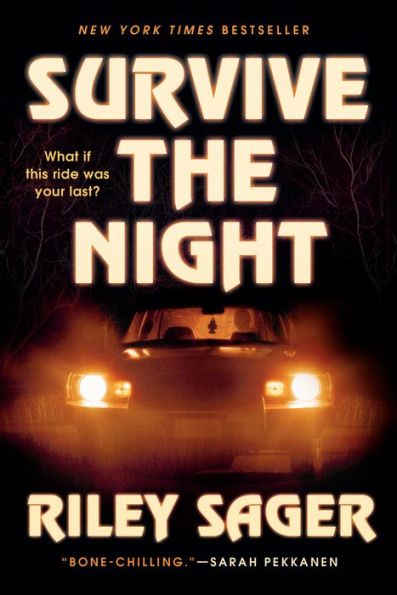
By Raelynn Harris ’25
According to How Long to Read, a website that gives its viewers information exactly about its namesake, the average reader, at a speed of 300 words per minute, would take four hours and forty minutes to finish Riley Sager’s Survive the Night. This can be true or false depending on how well a reader reacts to anxiety. Personally, Survive the Night took me two nights to read, half of it because of my daily routine, and the other half because of how nervous I became about the build-up to the climax.
Riley Sager, the pen name of Todd Ritter, author of eleven books, focuses on writing psychological thrillers. Survive the Night falls under that category and was published on June 29, 2021. Survive the Night is filled with suspense and a plot that makes the reader question every character’s motive. Similar to the book’s main character, Sager was a film study major but graduated from Penn State University. Survive the Night takes place in November 1991 and follows the main character, Charlie, after she drops out of college due to the trauma tied to her best friend Maddy’s murder. Charlie gets in a car for a trip from New Jersey to reach her home in Ohio with a man who possibly killed her best friend. Charlie soon realizes personas can always be a mask, no matter the person. Characters that tie into that and help Charlie find peace of mind are Maddy, Josh, Robbie, and Marge.
The overall feel of the book makes it seem as if you are watching a 90’s horror movie, which is alluded to multiple times in the book with the settings of scenes, especially when the anxiety and horror set in. The reader can’t completely trust the main character’s narrative, especially with the sudden breaks of reality in Charlie’s ‘movies.’ Charlie’s ‘movies’ started happening after the death of her parents, when she developed a coping mechanism through dissociation when watching a movie with her grandmother. Charlie spaces out and starts seeing how she goes through her life as a movie, internally changing lighting, and what people say around her by imagining a variety of genres. The realization that some of the dialogue might not be completely true sets in a feeling of distrust for everyone introduced, no matter if their role is big or small. Charlie’s narration of what she should do when in the car with a suspicious male is suddenly offset by the man asking what she saw when she picked up his dropped wallet at a pit stop. Charlie shakes it off, and it’s later revealed she was somewhat right about her suspicions.
The Campus Killer, who drives Charlie away after she loses her best friend to him, haunts Charlie’s thoughts and leads her to a large amount of guilt. An important element of why there is a large amount of guilt is that the movies that play in Charlie’s head and are a huge part of the story. Charlie thinks going back to where she started to cope with her grief is the best option. Deciding to move back home to Ohio with her grandmother, Charlie uses a campus ride board, which is a buddy system for trips with designated safe people that happened as a result of the murders around the college town. Charlie quickly grows suspicious of Josh, a stranger she met at the college’s riding board because of all the hints that he could possibly be the Campus Killer, but it’s too late for Charlie to run because the trip has already started.
The main parts of the book are labeled by the time, going from 9 p.m. to 3 a.m., with different roads as locations, but all in the same car. Most of the story takes place in the Volvo used for the trip, but also pitstops, and the college campus; which is mainly used for flashbacks and the events leading up to the trip.
The sudden switch between times and locations is both a strength and a weakness of the book. The switch from present to past can confuse the reader in a way that they’ll need to reread to figure out why the flashback is important to the story, but it also strengthens it because it reveals more hints about what had happened and foreshadows the character’s actions in the climax. For example, switching back to Charlie’s time with Maddy before she died and other characters’ actions afterward foreshadow elements of the climax.
Although most thrillers have plot twists, the plot twists in Survive the Night were somewhat unexpected with hints depending on the point of view and how you are processing and analyzing the book, especially with the knowledge of certain “rules” in the horror genre. Multiple characters have questionable motives and aren’t completely good or bad due to a thirst for vengeance, or a completely twisted mind. I felt so tense throughout the whole road trip that I had to put the book down at times to calm my mind.
Survive the Night, however, did seem to have a rushed ending. I don’t like that the main couple got together after the events of the night, and how their relationship seemed to happen right after. I think it would be cute if there would be some time and healing between what happened. I did like Charlie’s ‘movies’ in her head and how she wasn’t a completely reliable character, which led to a very good description in one of the final thrilling moments of the book. Charlie’s flip in point of view and her development was a very good turning point; I think it led to her having some closure to all of the traumatic events in her life. Although out of all characters presented in the book, including Charlie, Marge was my favorite, her anger and vengeance, although directed at the wrong person, was very satisfying and led to the moment in the hospital where Maddy was completely avenged.
Overall, I recommend Survive the Night for anyone who likes a thrill. Just be careful reading it at night!
